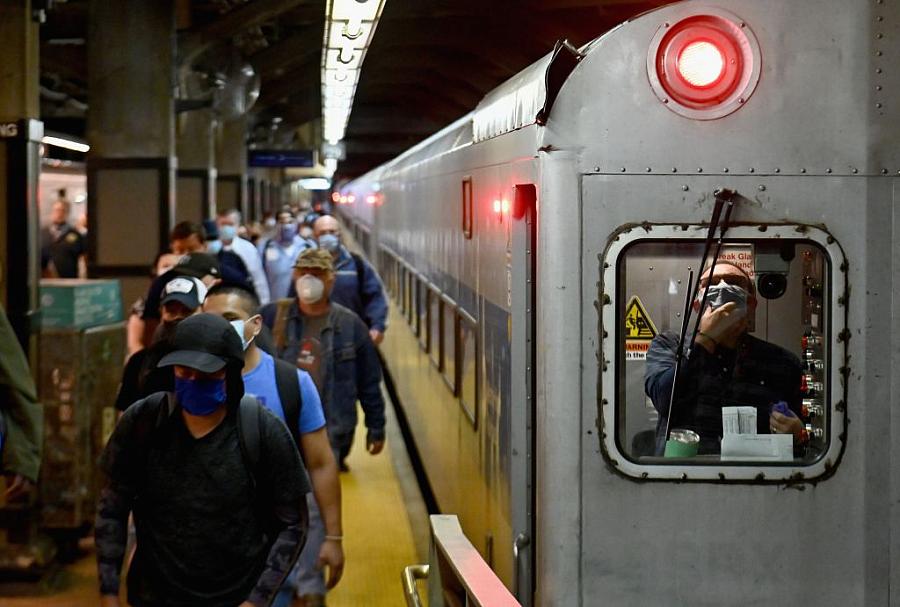Reopenings have become politicized — here’s how to report through the noise

(Photo by Angela Weiss / AFP)
As part of its “You Asked, We Answered” series, the Center for Health Journalism has been asking journalists what questions they have about reporting on COVID-19. Multiple reporters recently asked for recommendations for covering post-lockdown reopenings as they roll out across the country. Freelance reporter Giles Bruce spoke with experts in public health and journalism to get some answers.
As states, cities and businesses reopen after COVID-19 lockdowns, journalists must grapple with how to cover policies and decisions that have become largely policitized.
Some Americans protested the government-mandated closings of businesses and beaches — and publicly flouted them — while some governors and, in one case, a state Supreme Court, reopened states faster than many public health officials recommended. The issue has become even more fraught as crowds protesting the Minneapolis police killing of George Floyd have poured into streets in cities that are still shut down or just starting to open.
How should journalists report on a story — essentially a story of a pandemic — that has become more about politics and commerce than health and science?
“If a state has a governor who’s denying what the science is, or people with guns showing up at the statehouse, it’s hard to depoliticize it,” said Anne Donohue, an associate professor of journalism and co-director of the Global Health Storytellling program at Boston University. “It’s not journalists politicizing it. It’s citizens.”
We want to hear your questions about covering COVID-19 — scroll down and tell us or ask your question here!
She said her state is lucky to have a governor — Republican Charlie Baker — who is, in her (laudatory) words, the “most dull, calming person you could imagine.”
She recommends that reporters act the same way. She noted that even as “a very, very small number of” people protested stay-at-home orders, and many network news shows led their broadcasts with coverage of it, polls showed that a majority of Americans supported the restrictions.
“My general advice to all of my students is being boring is better than hyping,” she said. “It doesn’t have to be either or. Let’s try to be that calming voice rather than that sensational voice that gets us all scared.”
Dr. Amesh Adalja, a senior scholar at the Johns Hopkins University Center for Health Security, says journalists reporting on the reopenings should emphasize that COVID-19 is still out there.
“Biologically speaking, the virus hasn’t gone anywhere,” he said. “Social distancing requirements have gone into place mostly to preserve hospital capacity. … That’s what ‘flattening the curve’ was about.”
Having good data, and framing it properly, will also be important.
Adalja said that when journalists report on the inevitable spike in cases, they shouldn't automatically attribute it to the reopenings. Other factors also affect the case count, such as the disease’s incubation period and the availability of testing.
Rather than announce just the raw numbers of confirmed infections and deaths, he said, reporters should put the statistics into context. Increased testing will show more infections, so it’s important to ask what percentage of people tested are turning out to be positive. Another important question: What is the availability of local hospital beds?.
“The virus has established itself,” he said. “We’re going to continue to see cases and deaths. The question is, can we handle the number of cases that have to be hospitalized?”
He noted that some public health messages are self-explanatory — wear a seatbelt, don’t pick up a venomous snake with your bare hands — while many pandemic-related questions — Should I hang out with friends? Go to a wedding? — are more difficult to resolve, and personal.
“Already we’re seeing the consequences of delayed care, and that’s a big deal,” he said. “People are delaying preventive procedures — vaccines, mammograms, colonoscopies and annual physicals. And this is worrisome because the effects can stretch out into the future.”
— Dr. Paul Biddinger, Harvard T.H. Chan School of Public Health
As with so many other things, the answer comes down to the tradeoffs a person is willing to make.
“The solution to the absence of a vaccine and a curative therapy is social distancing,” Adajla said. “And social distancing does impair people’s quality of life.”
That doesn’t mean people should forgo needed or preventive medical care, said Dr. Paul Biddinger, director of executive and continuing professional education for the Harvard T.H. Chan School of Public Health.
“Already we’re seeing the consequences of delayed care, and that’s a big deal,” he said. “People are delaying preventive procedures — vaccines, mammograms, colonoscopies and annual physicals. And this is worrisome because the effects can stretch out into the future.”
Al Tompkins, a senior faculty for broadcast and online journalism at the Poynter Institute, compared the reopenings to the old physics lesson: For every action, there is an equal and opposite reaction.
“We know that reopenings are going to lead to more positive cases,” he said.
So journalists must accurately and fairly report those numbers, and let members of the public decide their own acceptable risk.
He says reporters don’t need to be “paternalistic” and tell people how to live their lives. At the same time, he wants to bust the myth that journalists somehow enjoy being the bearers of bad news.
“Just give me the truth as you know it. Whether you like it or don’t like the truth, give me the truth,” he said. “I don’t much care what you like or don’t like. No right-minded person wants to report how terrible the unemployment numbers are, or what retail sales look like. There’s no good news in that.
“I’ve heard people complain that journalists are profiting off bad news, which is ridiculous. Journalists are suffering at the same rate as everyone else, if not worse.”
**

